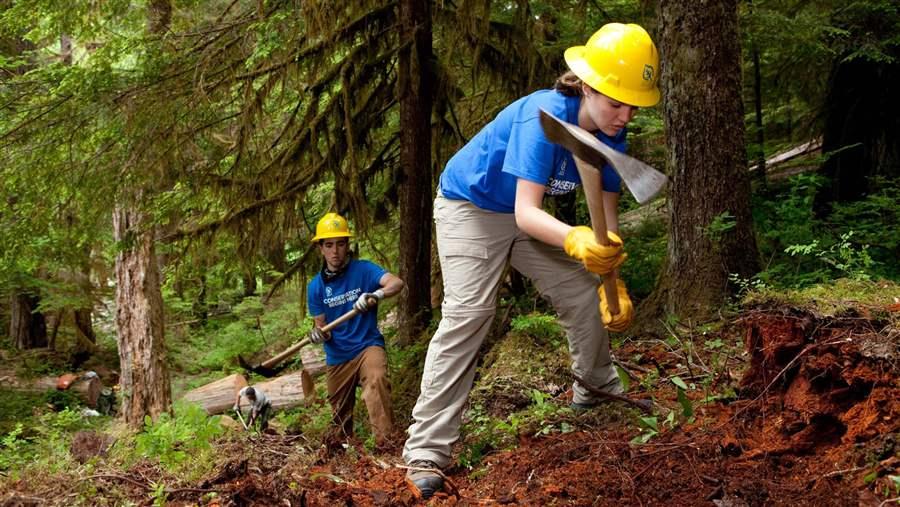A New Job Can Start With Park Repairs
Students and veterans gain skills and launch careers
Fixing our national parks means more than ensuring that they will be enjoyed by generations to come. The valuable work also can provide a chance to learn new skills. These public-private partnerships are rejuvenating our national parks while offering job training for hundreds of volunteers.

Veterans gather for a volunteer service day at Ebey’s Landing National Historical Reserve.
© The Pew Charitable TrustsIn 2016, The Mission Continues, the National Park Foundation, and Boeing joined together to help returning veterans find work protecting, restoring, and rebuilding America’s natural and cultural heritage. The Veterans in Parks program holds events at national parks across the country where post-9/11 veterans can volunteer and potentially build careers. The events are held at both urban and rural parks, including many that commemorate our nation’s military history.
To date, Mission Continues volunteers have helped improve accessibility at Fort Battery Ricketts, cleared trails at Ebey’s Landing National Historical Reserve, tended the hallowed grounds at Battleground National Cemetery, cleared downed trees at Crater Lake National Park, restored salmon habitat at Lewis and Clark National Historical Park, and helped refurbish parts of Fort Vancouver National Historic Site and many others.

Navy veteran Seth McIntosh (far left) stands with General Mark Toy (second from right), with the Army Corps of Engineers, and Concrete Preservation Institute staff at the Field School at Alcatraz.
© Tanya W. KomasThe Concrete Preservation Institute (CPI) trains soon-to-be-discharged active-duty military personnel and connects them to careers in construction while they repair national landmarks. Through CPI’s partnership with the National Park Service, the personnel work in Golden Gate National Recreation Area on Alcatraz Island and World War II Valor in the Pacific National Monument at Pearl Harbor.
During a 12-week training course, participants acquire skills with industry experts while they perform deferred maintenance work at the sites. Some of the largest concrete, construction, and equipment companies in the country support CPI and hire participants after they complete training and military service.
Students gain conservation expertise

Student Conservation Association regional crew members working in Olympic National Park.
© Joe Gersen/Student Conservation AssociationEach year, the Student Conservation Association (SCA) deploys thousands of young people to protect and restore our national parks. They range in age from 15 to young adults, hail from all 50 states, and have diverse socio-economic backgrounds. Modeled after the federal Civilian Conservation Corps program, which built much of our national park infrastructure in the 1930s and 1940s, SCA crews maintain and improve parks while receiving hands-on training in conservation. In 2016 alone, 9,638 SCA participants worked at 600 sites in all 50 states. They restored 180,000 acres of land and 3 million feet of shorelines, improved 10 million feet of trails, and constructed or maintained 20,000 structures. More than half are now working in or studying a conservation-related field.
Hope from hands-on preservation experience

HOPE crew members working on a historic house at the Martin Luther King Jr. National Historic Site in Atlanta.
© The Pew Charitable TrustsThe HOPE Crew Program, which stands for Hands-On Preservation Experience, is a National Trust for Historic Preservation initiative that trains young people in preservation crafts while they help to protect historic cultural sites on public lands.
With the help of craft experts, local members rehabilitate historic places. Since the project launched in 2014, HOPE crews have completed more than 100 projects in national parks. They include preserving headstones at Chalmette National Cemetery and Custer National Cemetery; rehabilitating mission structures at San Antonio Missions; and repainting historic houses at the Martin Luther King Jr. National Historic Site.
Partnerships like these not only help fix our parks; they provide critical job training that can launch new careers and inspire our next generation of national park stewards.
Join us next week to learn how corporate donations are helping to enhance the parks.
Marcia Argust directs The Pew Charitable Trusts’ campaign to restore America’s parks.









